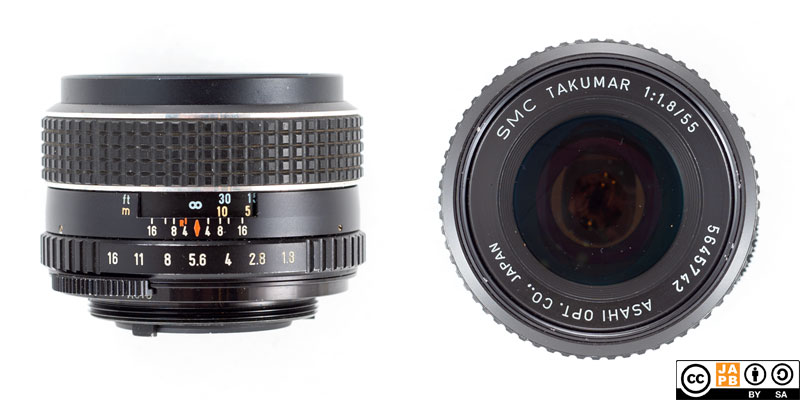Pekka Buttler, 06/2023

Specifications
The table below summarizes the lens’ key specifications (measurements are based on the pictured sample):
| Brand: | Asahi Opt.Co. (Pentax) | Lens name | SMC Takumar 1:1,8/55 |
| Focal length(s) 1 | 55 mm | Angle-of-view 2 | 43 ° |
| Maximum Aperture | f/1.8 | In Production | 1972–1975 |
| Lens mounts | m42 | Subfamily (if applicable) | –– |
| Length 3 | 39,2 mm | Diameter 4 | 59,1 mm |
| Filter ring diameter | 49 mm | Weight | 201 grams |
| Lens element count | 6 | Lens group count | 5 |
| Aperture blades (S/R/C) 5 | 6 S | Focus throw | 270 ° |
| Minimum focusing distance | 45 cms | Maximum magnification | 1:6,0 |
| Has manual aperture ring | YES | Has Manual focus ring | YES |
| Aperture mechanism type | Automatic/Manual | Aperture click stops 6 | 1.8•2.8•4•5.6•8•11-16 |
Further notes:
• Asahi/Pentax had a long tradition of manufacturing highly acclaimed nifty fifties. This lens among them.
• Early (before 1977) Asahi/Pentax nifty fifties had a focal length of 55 mm, while later offered the slightly wider 50 mm focal length. See more under ‘versions‘
• This (SMC) variant offered Pentax’ proprietary approach to allow open aperture metering on compatible m42 bodies.
History of Asahi / Pentax
The camera business today known Pentax was founded in 1919 as Asahi Kogaku Kogyo (Asahi Optical Company). Initially the company manufactured lenses for eyeglasses, later diversifying into projection lenses and even later into photographic lenses, supplying lenses for camera makers such as Konishiroku (Konica) and Molta (Minolta) and binoculars.
In 1952 – the year of the Helsinki olympiad – Asahi released the Asahiflex, the first Japanese 35 mm SLR. Together with its SLR cameras, Asahi introduced a line of lenses that carried the name ‘Takumar’, in honour of the founder’s brother.
In 1975 Asahi/Pentax introduced its own bayonet mount – The Pentax K mount – and phased out the production of m42 lenses and cameras. The name Takumar would remain on Pentax lenses until 1979 (and made some sporadic reappearances). The Pentax K mount is still a current mount, but it has several versions/generations. For details, see the JAPB article on the Pentax K mount.
Pentax was among the handful of Japanese camera manufacturers to keep up with the introduction of autofocus SLR cameras, and even survived the shift from film SLRs to digital SLRs (albeit somewhat struggling).
Versions
The list below summarises the major steps in the genealogy of the Asahi/Pentax 50–55 mm f/1.7–1.8 lenses.
m42 mount lenses:
• 1958–1958, ‘Takumar 1:1.8/55’, 6 elements in 5 groups, preset aperture, 10 blades
• 1958–1960, ‘Auto-Takumar 1:1.8 f=55 mm’, 6 elements in 5 groups, semi-automatic aperture, 10 blades
• 1960–1962, ‘Auto-Takumar 1:1.8/55’, 6 elements in 5 groups, automatic aperture, 6 blades
• 1962–1971 ‘Super Takumar 1:1.8/55’, 6 elements in 5 groups, automatic aperture, 6 blades
• 1971–1972, ‘Super-Multi-Coated TAKUMAR’, 6 elements in 5 groups, automatic aperture, 6 blades
• 1972–1975 ‘SMC Takumar’, 6 elements in 5 groups, automatic aperture (with open aperture metering), 6 blades [this lens]
Pentax K mount lenses:
• 1975–1977 ‘SMC Pentax 1:1.8/55’, 6 elements in 5 groups, f/22 minimum aperture (K-type Pentax K mount)
• 1977–1984 ‘smc Pentax-M 1:1.7 50 mm’, 6 elements in 5 groups (K-type Pentax K mount) [data sheet]
• 1984–1989 ‘smc PENTAX-A 1:1.7 50mm’, 6 elements in 5 groups (KA-type Pentax K mount)
• 1987–1991 ‘smc PENTAX-F 1:1.7 50’, 6 elements in 5 groups (KAF-type Pentax K mount)
• 1991–2004 ‘smc PENTAX-FA 1:1.7 50mm’, 6 elements in 5 groups (KAF-type Pentax K mount)
Adapting
If you want to natively mount this lens you need to find a functioning m42 mount film camera. Luckily that should be relatively easy as m42 bodies were produced in their millions and most of them lack features that are especially likely to have deteriorated to the point of making the entire camera inoperable.
Adapting this lens to a mirrorless, full-frame digital camera is a breeze thanks to the lens having full manual controls (aperture ring, focus ring). You simply need a dumb adapter from m42 to your mirrorless system (And set the lens in manual mode to be sure the aperture works as you intend).
Due to the medium flange focal distance used by the m42 mount (45,46 mm), whether you can adapt this lens to dSLR/SLR mounts depends on which dSLR mount: Canon EF, Four Thirds, Minolta/Sony A and Pentax K can mount m42 lenses using a simple adapter ring. Nikon F on the other hand is not as problem-free, and – to retain anything near infinity focus – the adapter will necessitate corrective optics. In all cases, your camera will work only in stop-down metering.
Footnotes
- Focal length is (unless stated otherwise) given in absolute terms, and not in Full-frame equivalent. For an understanding of whether the lens is wide/tele, see ‘Angle-of-view’. ↩︎
- Picture angle is given in degrees (based on manufacturers’ specs) and concerns the diagonal picture angle. Rule of thumb:
> 90 ° ==> Ultra-wide-angle
70–90 ° ==> Wide-angle
50–70 ° ==> Moderate wide-angle
40–50 ° ==> ‘Standard’ or ‘normal’ lens
20–40 ° ==> Short tele lens
10-20 ° ==> Tele lens
5-10 ° ==> Long tele lens
< 5 ° ==> Ultra-tele lens ↩︎ - Length is given from the mount flange to the front of lens at infinity. ↩︎
- Diameter excludes protrusions such as rabbit ears or stop-down levers. ↩︎
- S=straight; R=rounded; C=(almost)circular at all apertures. ↩︎
- Numbers equal aperture values on aperture ring; • intermediate click; – no intermediate click. ↩︎